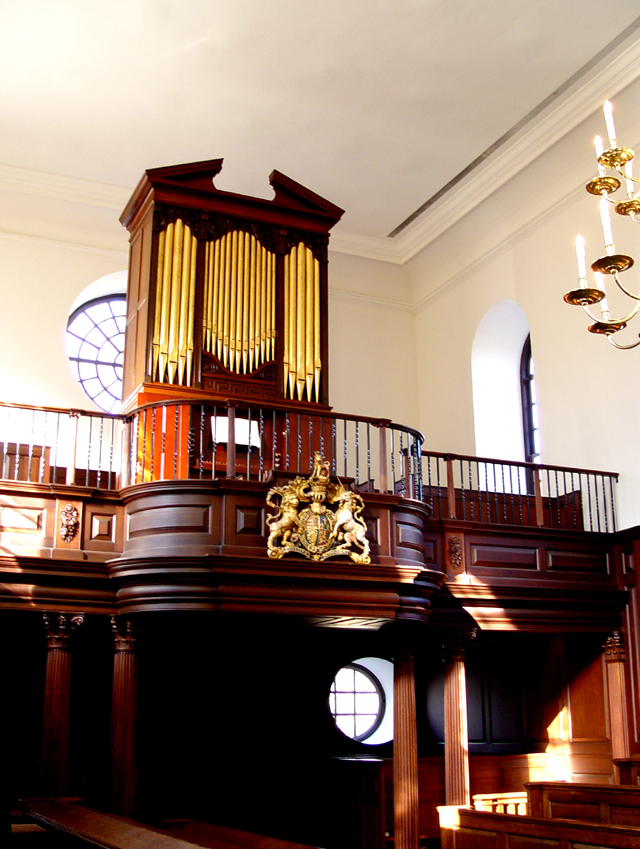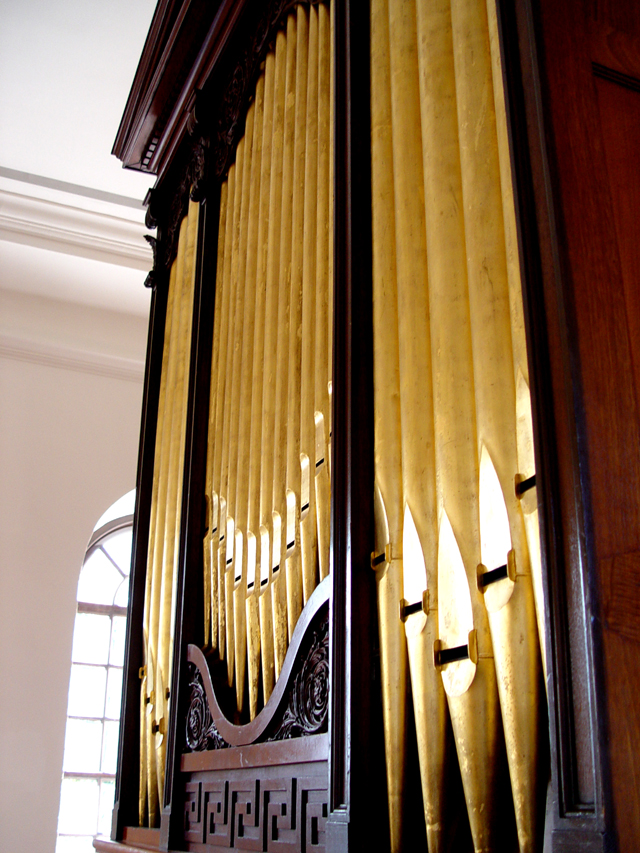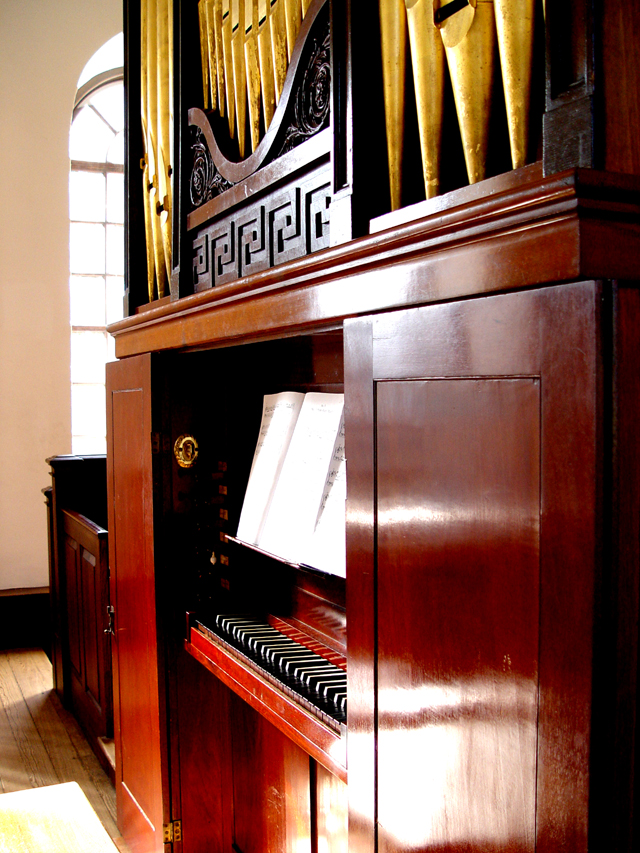
Photography by John DeMajo
 |
THE CHURCHES OF VIRGINIA
Photography by John DeMajo |
THE CHAPEL OF SIR CHRISTOPHER WREN THE COLLEGE OF WILLIAM AND MARY Williamsburg, VA. |
 |
Main entrance doors and organ gallery view - interior view of Wren Chapel |
AMERICA'S SECOND OLDEST COLLEGE
The College of William & Mary is the second-oldest college in America. The original plans for the College date back to 1618—decades before Harvard—but were derailed by an “Indian uprising.” We couldn’t make this stuff up. On February 8, 1693, King William III and Queen Mary II of England signed the charter for a “perpetual College of Divinity, Philosophy, Languages, and other good Arts and Sciences” to be founded in the Virginia Colony. And William & Mary was born. Workers began construction on the Sir Christopher Wren Building, then known simply as the College Building in 1695, before the town of Williamsburg even existed. Over the next two centuries, the Wren Building would burn on three separate occasions, each time being re-built inside the original walls. That makes the Wren the oldest college building in America, and possibly the most flammable. The College has been called “the Alma Mater of a Nation” because of its close ties to America’s founding fathers. A 17-year-old George Washington received his surveyor's license through the College and would return as its first American chancellor. Thomas Jefferson received his undergraduate education here, as did presidents John Tyler and James Monroe. William & Mary is famous for its firsts: the first U.S. institution with a Royal Charter, the first Greek-letter society (Phi Beta Kappa, founded in 1776), the first student honor code and the first law school in America. The College became a state-supported school in 1906 and went coed in 1918. In 1928, John D. Rockefeller, Jr. chose the Wren as the first building to be returned to its 18th-century appearance as part of the iconic Colonial Williamsburg restoration. (exerpt from the college's website) |
The altar of Wren Chapel |
Bruton Parish’s organist emeritus, James S. Darling, as he completes a Saturday morning recital as part of the Bruton Parish concert series. |
A view of the chapel from the organ gallery |
One of the markers commenting the history of the chapel and of William and Mary College |
 |
The History Of The Organ |
The Wren Chapel organ is among the four oldest organs in the United States. It was bought in England by Colonial Williamsburg and imported to America to reside in the ballroom of the Governor's Palace, which is adjacent to the college in Williamsburg. It was once believed that the instrument was attributed to Snetzler, which has since been disproved. During a renovation of the Palace in the 1920's, John D. Rockerfeller, Jr. spotted the instrument and ordered it out of the Ballroom. It was then placed, as a silent piece of furniture, in the hallway of the Williamsburg Lodge where it remained for years. Some decades ago, it was placed into the balcony of Wren Chapel where it was an ideal fit. Today it is used regularly for recitals, weddings and other functions. |
The following information is from the College's official web site: The Sir Christopher Wren Building is the oldest college building in the United States and the oldest of the restored public buildings in Williamsburg. It was constructed between 1695 and 1699, before the city was founded, when the capital of the colony of Virginia was still located at Jamestown, and the tract of land which was to become Williamsburg was populated by simple timber buildings and known as "Middle Plantation." Chartered on February 8, 1693, by King William III and Queen Mary II of England, the new college was to consist of three schools: a classical grammar school in which boys about twelve to fifteen years of age could prepare for college; the philosophy school (the collegiate curriculum); and the divinity school, where young men who had completed their studies in the philosophy school would be prepared for ordination in the Church of England. During the colonial period, the Wren Building accommodated all the activities of the college. It housed students and contained classrooms, a library, a refectory, a faculty room, as well as living quarters for the president and masters. Today, as the Wren Building enters its fourth century, it continues in use as an academic building with faculty offices on the third floor and classrooms throughout the building. Known in the eighteenth century simply as "the College," and later as the "Main Building," William and Mary's oldest and most cherished building was renamed in 1931 for the famous British architect, Sir Christopher Wren, to whom an eighteenth-century author attributed the design. Fire has gutted the Wren Building three times -- in 1705, 1859, and 1862 -- and each time it has been rebuilt with the original exterior walls incorporated into the reconstruction. It was restored to its colonial appearance in 1928–31 through the generosity of John D. Rockefeller, Jr. There was a close official connection between the College and the Church of England during the colonial period, and William and Mary students would have begun and ended each day with services in the chapel. After the American Revolution, William and Mary maintained an unofficial relationship with the Episcopalian Church until the College became a state institution in 1906. Today the chapel continues to be used for student worship services of various denominations, as well as for music recitals, solemn induction ceremonies, and alumni weddings. The design of the chapel is similar to that of many collegiate chapels in Great Britain. The paneling is of native pine and walnut. The English eighteenth-century chamber organ is on loan to the College from the Colonial Williamsburg Foundation, as is the antique chandelier. The royal arms of Kings George I and II are displayed on the front of the gallery, a reminder of the close connection between Church and State during the College's early years. Among those buried in the crypt under the Chapel are several distinguished Virginians--Sir John Randolph, his sons John "the Tory" and Peyton, Bishop James Madison--as well as Lord Botetourt, the beloved colonial governor, a statue of whom can be seen in front of the Wren Building. |
ORGAN SPECIFICATIONS |
8 Stopped Diapason |
 |